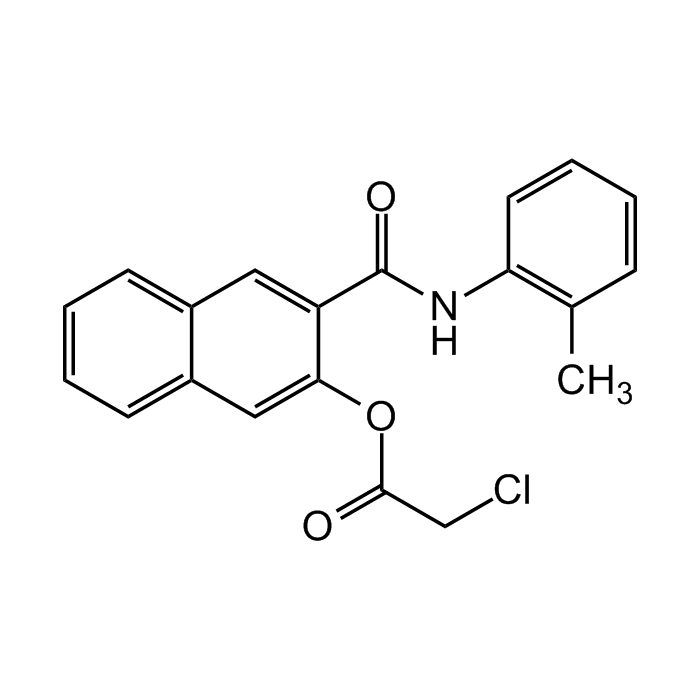Cookie Policy: This site uses cookies to improve your experience. You can find out more about our use of cookies in our Privacy Policy. By continuing to browse this site you agree to our use of cookies.
Chemodex
Naphthol AS-D chloroacetate

| Product Details | |
|---|---|
| Synonyms | 3-Hydroxy-2-naphthoic-o-toluidide chloroacetate |
| Product Type | Chemical |
| Properties | |
| Formula | C20H16ClNO3 |
| MW | 353.8 |
| CAS | 35245-26-2 |
| Source/Host Chemicals | Synthetic |
| Purity Chemicals | ≥99% (HPLC) |
| Appearance | White to off-white powder. |
| Solubility | Soluble acetone (50 mg/ml). |
| Identity | Determined by 1H-NMR. |
| Declaration | Manufactured by Chemodex. |
| Other Product Data |
Click here for Original Manufacturer Product Datasheet |
| InChi Key | FMVKYSCWHDVMGO-UHFFFAOYSA-N |
| Smiles | O=C(NC1=C(C)C=CC=C1)C2=CC3=CC=CC=C3C=C2OC(CCl)=O |
| Shipping and Handling | |
| Shipping | AMBIENT |
| Short Term Storage | +4°C |
| Long Term Storage | -20°C |
| Handling Advice |
Keep under inert gas. Very hygroscopic. |
| Use/Stability | Stable for at least 2 years after receipt when stored at -20°C. |
| Documents | |
| Product Specification Sheet | |
| Datasheet |
 Download PDF Download PDF |
Naphthol AS-D chloroacetate (NASDCA) is a fluorigenic substrate for granulocyte specific esterases (e.g. Proteinase 3 (PR3) and Cathepsin G). It can be hydrolyzed into Naphthol AS-D by esterases to mix with diazonium salt and form insoluble red-brown precipitate in the cytoplasm that can be visualized under a microscope. This enzyme is usually considered specific for cells of granulocytic lineage. NASDCA can be used for the visualisation of cells in formalin-fixed or paraffin-embedded tissue in a substrate solution for naphthol-AS-D-chloroacetate-esterase (CIAE) staining. Proteinase 3 (P3R) is a serine protease that is found in neutrophils and a subpopulation of monocytes. It is the most specific enzyme for NASDCA hydrolysis, and it is used in a variety of diagnostic tests to detect granulocytes. Cathepsin G is another serine protease that is found in neutrophils. It can also hydrolyze NASDCA, but it is not as specific as PR3. Human leukocyte elastase is a serine protease that is also found in neutrophils. It can hydrolyze NASDCA, but it is not as specific as PR3 or cathepsin G. It is important to note that not all granulocytes will stain positive for NASDCA. Basophils and eosinophils do not contain PR3, so they will not stain positive for NASDCA. However, neutrophils and a subpopulation of monocytes do contain PR3, so they will stain positive for NASDCA.
(1) W.C. Moloney, et al.; Histochem. Soc. 8, 200 (1960) | (2) L.-D. Leder; Blut 21, 1 (1970) | (3) A. Vaughan, et al.; Anal. Chem. 43, 721 (1971) | (4) R. Rindler, et al.; Blut 26, 239 (1973) | (5) D.M. Swirsky; J. Clin. Pathol. 37, 1187 (1984) | (6) K.-W. Lam, et al.; Stain Technol. 60, 169 (1985) | (7) M.G. Braun, et al.; Hematol. Oncol. 14, 83 (1996)





